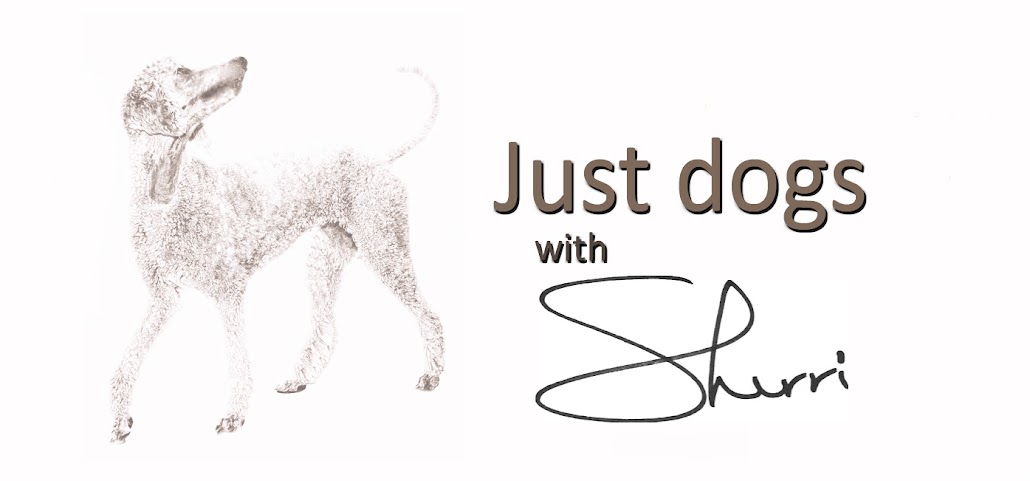Calm and relaxed.
Yesterday as Elsa and I rounded the last corner of the park; we came across a woman with four small to medium sized dogs. It was clear that she was trying to stay away from us; which was perfectly fine with me. We got about 20 feet from each other when one of the dogs started to lunge and growl intimidatingly. We ignored them until I noticed the yanking. She was yanking and yanking on the poor dog's neck with a choke collar. I was cringing as we slowed our pace; finally coming to a full stop to watch. The harder she yanked the more angry the little dog got. Before long the dog was no longer growling at Elsa but was directing his aggression towards the owner. She got madder, so did the dog.
At that point we were complete outsiders looking in. It went from us being the trigger to the owner receiving most of the aggression. This was not a typical redirected aggression case; the dog was pissed at being yanked on. Redirected aggression can happen anytime a dog is displaying aggression combined with frustration. They can lash out to family member, canine sibling or inanimate objects. This dog was clearly directing his aggression at the owner; because as soon as she yanked him he turned on a dime and growled fiercely at her.
Leash aggression is very common; it is also common for an owner to feel as though they are the only one out there with a crazed dog on the end of their leash. Many very friendly dogs display leash aggression; heck Luke use to do it all the time and every so often he will do it now. He is very social, he has never been in a fight and if provoked would rather walk away. Leash aggression occurs because our dogs are not free to speak. They cannot communicate or move freely in the situation. Dogs that display leash aggression are typically highly alert types; they are constantly watching for signals. For Luke it is almost always a highly held tail or posture; plus there are some specific breeds that he tends to focus in on. Of course there are leash aggressive dogs who are actually aggressive.
When a dog displays leash aggression; you are in fact seeing how they feel about walking past other dogs. Their outburst gives you very important information that you need to deal with. What you do with that information will forecast the future displays. Taking the information and changing it is the first step. You need to change how your dog feels about walking by other dogs. Just dealing with the outburst itself will not help; you must make a new association to walking past other dogs.
What will make or break a dog who displaying leash aggression is your reaction. Do you get mad and yank, yell and do basically the same thing that your dog is doing? Then it's going to get worse, guaranteed. The woman in the park with the leash aggressive dog thought that her aggressive behaviors would convince the dog to stop; it was actually fueling the behavior.
Your actions can mimic a prong collar in fueling the problem. Prong/pinch collars are notorious for delivering pain which results in stress and over stimulation. When you create an association of anger and stress caused by your dog's leash aggression, you fuel the behavior. What are you showing your dog? You are displaying a highly stressed and angry state; remember your dog is watching you. What could begin with a small leash aggression display will be pumped up because of your added stress display.
I can almost guarantee that you tip your dog off before they even begin. The tightening of the leash is typically the first sign. That leash tightening also causes more stress because you sap your dog's freedom of movement away even more. Yes you need to keep your distance but don't do it in a way that fuels the issue. Reel slowly so that your dog doesn't notice; step off of the path or sidewalk and give yourself some room to breath and work. Take a big breath and chill; at least pretend to chill.
The biggest problem with leash aggression is the person on one end of the leash. You MUST remain calm or you will have no chance of rehabilitating or helping your dog. The whole thing should start before your dog sees another dog; so that means that you need to be on your toes. As soon as you see another dog you should immediately slip into your "chill," zone. Getting yourself under control is the first and hardest thing for many people. It is an essential first step, so get to work.
Got questions? Need a consult? Talk to me now.


Well said Sherri. As an animal behaviourist and dog trainer I have a lot of clients coming to me with the same problem. I use Behaviour Adjustment Training with most cases because this keeps them below their trigger threshold. I also teach the 'Watch me' command so that if they find themselves in a position with not enough room to move away it gives them and their dog something else to focus on. Obviously the 'watch me' command is initially taught at home and then generalised within their own environment before taking it out in public. I have had a few clients also who were initially shown the 'lead jerk' reaction and as your article states, a lot of these ended up with transition aggression. There are kind methods of solving lead aggression and thankfully more and more people are becoming aware of this.
ReplyDelete